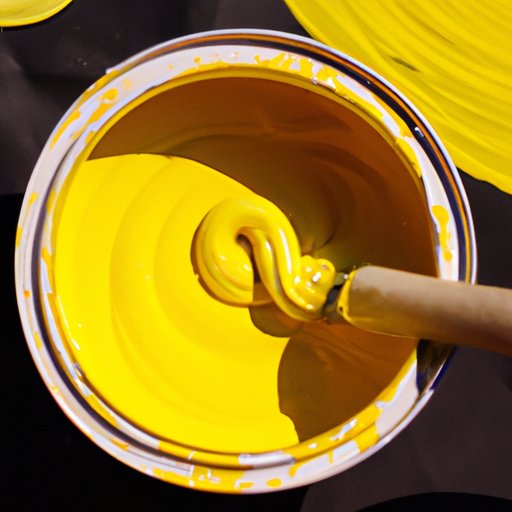
Introduction
Have you ever found yourself in the middle of an art project, completely out of yellow paint? Or, maybe you’re interested in creating a unique shade of yellow that can’t be found in stores. Regardless of your reason, making your own yellow paint at home can be a fun and rewarding experience.
In this article, we’ll provide you with a step-by-step guide on how to make homemade yellow paint. You’ll learn about the necessary ingredients, materials, and safety measures to take, as well as tips for mixing colors and expert advice for creating the perfect paint.
The Recipe for Making Homemade Yellow Paint: Step-by-Step Guide
The first step in making homemade paint is gathering the necessary ingredients. You’ll need:
- Yellow pigment
- Binder (such as linseed oil or egg yolk)
- Solvent (such as mineral spirits or turpentine)
- Additive (optional, such as driers or extenders)
Each of these ingredients plays an important role in the paint-making process. The pigment provides the color, the binder holds everything together and makes the paint stick to surfaces, the solvent thins out the mixture so it can be spread easily, and the additive can adjust the drying time or consistency of the final product.
Next, follow these steps to make homemade yellow paint:
- Mix the pigment and binder together thoroughly on a palette knife or glass muller. This creates a smooth and even consistency in the paint.
- Add a small amount of solvent to the mixture and continue mixing. The amount of solvent you add depends on the thickness you want your paint to be. Be careful not to add too much solvent, which can make the paint too runny and difficult to control.
- If desired, add an additive to the mixture. Again, the amount you add will depend on the effect you want the additive to have on the paint.
- Mix everything together until the paint reaches the desired consistency. You should now have a smooth, even yellow paint ready to use!
DIY Yellow Paint: Materials Needed and Safety Measures to Be Taken
In addition to the ingredients, you’ll need a few materials to make your own yellow paint:
- Palette knife or glass muller
- Paintbrushes
- Container for mixing (a palette or plastic cup works well)
- Surface to paint on
When working with these materials, it’s important to take safety measures to protect yourself and your surroundings. Make sure you’re working in a well-ventilated area, wear gloves to protect your skin from the paint and any chemicals you’re using, and dispose of any materials properly when you’re finished.
Mixing Colors: Creating Unique Shades of Yellow for Your Paint
One of the benefits of making your own paint is the ability to create custom colors. To do this, it’s important to understand the color wheel and how different colors can be mixed to create new shades.
If you want to lighten your yellow paint, add a small amount of white paint to it. If you want to darken it, add black. For a more orange-yellow hue, add some red. For a more green-yellow hue, add some green. Play around with different amounts of each color to create the shade that’s perfect for your project.
Yellow Paint from Natural Pigments: Exploring Options for Eco-Friendly Painting
If you’re interested in using more eco-friendly materials for your paint, natural pigments are a great option. Not only are they better for the environment, but they can also produce interesting and unique colors.
Some natural pigments that can be used to make yellow paint include turmeric and saffron. To make yellow paint using one of these pigments, follow a similar process to the recipe above, but use the natural pigment instead of the synthetic one.
Expert Tips for Making the Perfect Yellow Paint: Mistakes to Avoid, Best Practices to Follow
While making homemade yellow paint can be a fun and rewarding experience, there are some common mistakes people make that can affect the quality of the final product. Here are some expert tips to follow to make sure you end up with the perfect yellow paint:
- Use a high-quality pigment to ensure the color is vibrant and long-lasting.
- Don’t use too much pigment or binder, which can make the paint too thick or dry too slowly.
- Take your time when mixing everything together, making sure to get an even consistency.
- Store your paint in a cool, dry place to prevent it from drying out or spoiling.
Conclusion
Making your own yellow paint at home is a fun and creative way to explore your artistic side. By following our step-by-step guide, you’ll have all the knowledge you need to create high-quality, beautiful paint that’s perfect for your next project.
Remember to take safety measures when working with the materials, and don’t be afraid to experiment with different shades of yellow by mixing colors or trying natural pigments.





